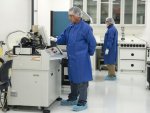
Medical device makers hope to kill a tax
Print
03 December 2014
Bernard J. Wolfson, Orange County Register
The issue has keen interest in Orange County, a hotbed of medical device manufacturing with more than 250 firms employing tens of thousands of people.
 John Kilcoyne, the CEO of ReVision Optics, hopes the return of a Republican majority to the U.S. Senate will mean the end of a tax on medical devices that he says is stifling the business prospects of his company and many of its peers.
John Kilcoyne, the CEO of ReVision Optics, hopes the return of a Republican majority to the U.S. Senate will mean the end of a tax on medical devices that he says is stifling the business prospects of his company and many of its peers.
The Lake Forest company, which is developing a gel-based inlay to correct the common, age-related loss of close-range vision, does not yet have any U.S. revenue and is therefore not actually subject to the 2.3 percent tax on domestic sales of medical devices. But Kilcoyne worries that the prospect of being taxed in the future will drive away potential investors now, making it more difficult to bring his product to market.
“Venture capitalists are investing their money in year one and they have to wait 10 years to hopefully see regulatory approval. And the first thing that happens when you finally have approval is that the first 2.3 percent of revenue goes back to the government,” Kilcoyne laments.
When you add the device tax to the long lead time for approval and the many millions of dollars spent along the way, he says, “it’s death by a thousand lashes.”
Kilcoyne could be the poster boy for the entire medical device industry, which let out a collective “hallelujah” after Tuesday’s midterm election. That was especially true in Orange County, a hotbed of medical device manufacturing with more than 250 firms employing tens of thousands of people.
Mitch McConnell, R-Ky., who will become the new Senate Majority Leader come January, has made a repeal of the device tax one of his top priorities. And he can count on the support of many Democrats in Congress who also oppose the tax.
After McConnell broached the subject following his election victory Tuesday, President Barack Obama did not issue a veto threat.
The device tax is one of many levies written into the 2010 Affordable Care Act – aka, Obamacare – to help pay for the expansion of health insurance coverage.
It was originally expected to raise $30 billion over 10 years, but that figure was recently downgraded to $26 billion by the congressional Joint Committee on Taxation. The committee found that in 2013, the first year the tax was collected, it generated about 25 percent less than had been previously estimated.
The medical device industry and many outside observers say the tax is dampening investment in innovation and jobs. The proponents of repeal also argue that the tax lengthens the path to profitability for smaller device companies while diminishing the profits of the larger, more established ones.
“It’s a bad idea in the sense that it’s on the gross revenues, not on profits, so it hurts small device companies that might not be making much profit at all,” says Paul Feldstein, professor emeritus at UC Irvine’s Paul Merage School of Business.
“The other thing is that it doesn’t stay with the manufacturer. It gets passed on to hospitals and other places, and that ends up in higher health insurance premiums, and that’s a regressive tax.”
People who favor keeping the tax say it is only fair the device industry should help pay for a law that, by expanding health coverage to millions of Americans, will create new demand for its products. After all, the pharmaceutical industry is being taxed to the tune of $34 billion over 10 years, and health insurance companies are expected to pay about $102 billion into the kitty over that period.
Another $110 billion is expected to come from a “Cadillac” tax on high-end health plans, starting in 2018.
Those who oppose repealing the tax also argue that there is no compelling evidence to corroborate the deleterious effects cited by the medical device industry.
A study issued earlier this week by the Congressional Research Service predicted “fairly minor effects” on production and employment; a “negligible” impact on the cost of health care; and no significant consequences for innovation.
The scope of the tax is also limited. For one thing, medical device makers that sell directly to hospitals and medical offices rather than through wholesale distributors are taxed on only 75 percent of the sales price. Moreover, the tax is only levied on sales inside the U.S. – a big advantage to some of the larger firms with significant overseas business.
Irvine-based heart-valve maker Edwards Lifesciences, which paid $20 million last year and expects to pay a similar amount in 2014, is subject to the tax on less than half its total revenue, since 54 percent of the company’s sales are overseas.
“The tax is not bad as taxes go,” said Paul N. Van de Water, an analyst at the Center for Budget and Policy Priorities in Washington, D.C., which advocates keeping the device tax. “Any tax is going to have some negative effects, but the effects of this particular tax are few and far between.”
Nonetheless, with McConnell and House Speaker John Boehner in agreement, a repeal could be pushed to the top of the legislative agenda as early as January.
There is strong bipartisan support for erasing the tax. The House has already passed legislation to eliminate it, and the Senate last year approved a nonbinding repeal in an amendment to a budget bill by a vote of 79-20. Thirty-four of the Senate’s 55 Democrats voted for the repeal, including liberal icons Elizabeth Warren, D-Mass., and Al Franken, D-Minn.
“I think it’s a no-brainer that will go through in a bipartisan way,” says UCI’s Feldstein. “The only problem is where does the money come from to pay for that.”
Some think it may not even be necessary to find offsetting savings.
“Keep in mind this is a very small piece of the Affordable Care Act – a $30 billion piece of a $1 trillion deal,” says Steve Ubl, CEO of the Advanced Medical Technology Association, or AdvaMed, the device industry’s main lobbying arm. “Plus it’s generating 25 percent less than anticipated, which makes it less expensive to repeal.”
Van de Water says excusing the industry from the tax would set a “dangerous” precedent. “To paraphrase (former Illinois Sen.) Everett Dirksen, 26 billion here, 26 billion there, and pretty soon you’re talking about real money.”
The Congressional Research Service report noted that if the medical device tax were eliminated, other industries that are being taxed to help fund the Affordable Care Act might step forward to claim similar treatment.
“Those losses would present a more significant challenge in finding alternative revenue sources,” the report said.
Proponents of repealing the device tax say that doing so could interject a long-missing note of bipartisanship in Washington.
“I think the message from the voters was pretty clear that they want both sides to work together,” says Ubl, the industry’s lobbyist-in-chief. “That kind of bipartisan deal-making is a governing muscle that has atrophied quite a bit, and we see the medical device repeal as a great opportunity to rebuild it.”
Photo: LEONARD ORTIZ
All Portfolio
MEDIA CENTER
-
The RMI group has completed sertain projects
The RMI Group has exited from the capital of portfolio companies:
Marinus Pharmaceuticals, Inc.,
Syndax Pharmaceuticals, Inc.,
Atea Pharmaceuticals, Inc.





